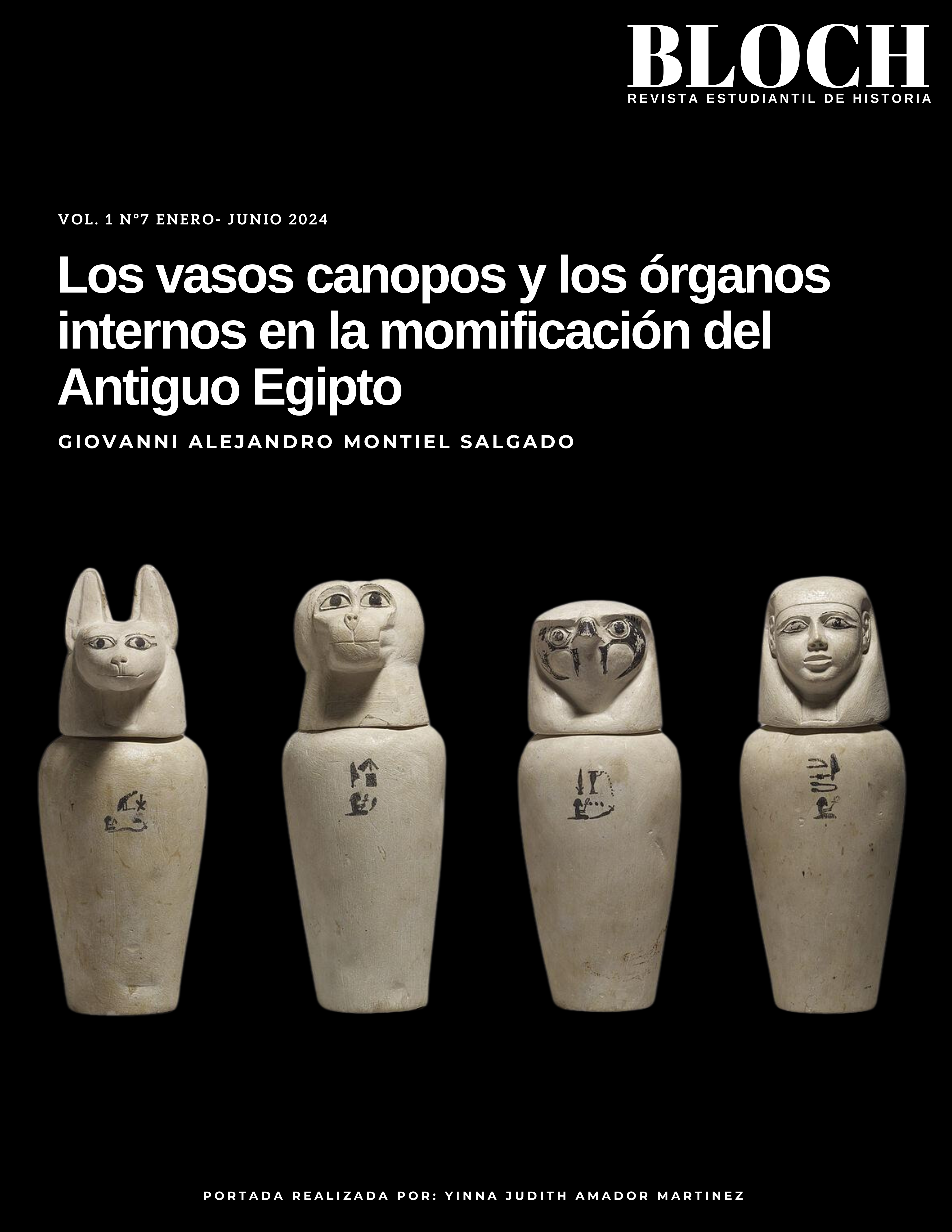The The Canopic Jars And The Internal Organs In The Ancient Egypt Mummification

Published 2024-07-20
Keywords
- Canopic Jars,
- Egyptian Mummification,
- Four Sons Of Horus,
- Internal Organs,
- Egyptian Cosmovision
How to Cite
Copyright (c) 2024 Giovanni Alejandro Montiel Salgado

This work is licensed under a Creative Commons Attribution 4.0 International License.
Abstract
The Egyptian mummification process is one of the most characteristic of the ancient north-African culture; it was packed of different and interesting facets and meanings which looked for prepare and provide the deceased of and for anything that they would need in the other life. One of the most important processes of body’s physic conservation and symbolic protection was the extraction of the internal organs, specifically the lungs, the stomach, the liver, and the intestines, which were introduced in special containers named canopic jars, whose function was to protect the internal organs of the deceased who they belonged to. The canopic jars had moulded in their lids the Four Sons of Horus’s heads who, along with other Protection Goddess and according to the Egyptian cosmovision, performed the task described.
The following paper looks for remark the most important generalities of these canopic jars when they acquire the shape of the mentioned Four Sons of Horus’s heads in their lids, plus talking about the organs treatment when they were taken out of the abdominal cavity.
Downloads
References
- ANDREWS, Carol. Amulets of the Ancient Egypt. Austin: University of Texas Press, 1994.
- BRIER, Bob. Las Momias de Egipto. Las Claves de un Arte Antiguo y Secreto. Barcelona: Edhasa, 1996.
- CARDONA, Castro Francisco L. (dir.). Napoleón. Madrid: Edimat Libros/Grandes Biografías, 1991.
- CASANOVA, Ildefonso R. “Las Cuatro Antorchas de Glorificación: Ritos funerarios egipcios”. Arte, Arqueología e Historia, s.v. (2014), 191-198.
- CASSAN, Adolfo. El Gran Libro del Cuerpo Humano 6ª ed. Barcelona: Parramón, 2013.
- DRIOTON, Etienne y Jacques Vandier. Historia de Egipto, 6ª ed. Buenos Aires: EUDEBA, 1981.
- GARZÓN RODRÍGUEZ, Judit. “Los Cuatro Hijos de Horus”. ArtyHum. Revista Digital de Artes y Humanidades s.v. (julio de 2016), 113-121.
- HERÓDOTO DE HALICARNASO [c. 484 – 425 a.n.e.]. Historias vol. II, trad. por Jaime Berenguer Amenós. Madrid/Barcelona: Consejo Superior de Investigaciones Científicas, 1971.
- LACE, William W. Mummification and Death Rituals of Ancient Egypt. San Diego: Reference Point Press, 2013.
- MELLADO, Esther P., Silvia Badillo, Javier Carrascoso y Vicente Martínez de Vega. “Momias Humanas Egipcias. Un viaje en el tiempo. Del País del Nilo al Museo Arqueológico Nacional”. Boletín del Museo Arqueológico Nacional s.v. (2018), 391-408.
- RODRÍGUEZ V., Roberto. “El Vaso Canopo de Apofis I”. Revista de Claseshistoria. Publicación digital de Historia y Ciencias Sociales s.v. (noviembre de 2013), 1-13.
- SCHULZ, Regine y Matthias Seidel (eds.). Egipto. El Mundo de los Faraones. Königswinter: Konemann, 2004.
- THE BRITISH MUSEUM PRESS. El Antiguo Egipto en el Museo Británico. Madrid: Alianza Editorial, 2004.
- TOMORAD, Mladen e Igor Uranić. “The Egyptian Collection of the Museum of the City of Varaždin, Croatia”. Trabajos de Egiptología-Papers on Ancient Egypt (TdE) 3 (2006), 1-10.
- VILLARRUBIA, Antonio. “Menelao en la Mitología y la Literatura Griegas”. Habis s.v. (1986), 45-62.
- DODSON, Aidan. “Canopic Equipment: Beauty and Revelations of from Ancient Egypt”. American Researh Center in Egypt, s.f., disponible en [https://www.arce.org/resource/canopic-equipment-beauty-and-revelations-ancient-egypt].
- DICCIOMED. Diccionario médico-biológico, histórico y etimológico. Natrón, s.f., disponible en [https://dicciomed.usal.es/palabra/natrón].
- ENCYCLOPEDIA.COM. Muu Dancers, s.f., disponible en [https://www.encyclopedia.com/humanities/culture-magazines/muu-dancers#:~:text=Muu%2Ddancers%20were%20a%20feature,dwarfs%20by%20the%20Twentieth%20Dynasty.].
- ENCYCLOPEDIA BRITANNICA. Canopic Jar. Egyptian Funerary Vessel, s.f., disponible en [https://www.britannica.com/topic/canopic-jar].
- Química.es. Natrón, s.f., disponible en [https://www.quimica.es/enciclopedia/Natr%C3%B3n.html].
- SPURLOCK MUSEUM OF WORLD CULTURES. University of Illinois Urbana-Champaign. Artifacts: Canopic Jars, s.f., disponible en [https://www.spurlock.illinois.edu/exhibits/online/mummification/artifacts4.html].
- MUSEO NACIONAL DE BELLAS ARTES DE CUBA. Juego de vasos canopos de Nes-Chou-Tefnout., Período saíta. Dinastía XXVI 664 - 525 a.n.e., s.f., disponible en [https://www.bellasartes.co.cu/obra/anonimo-juego-de-vasos-canopos-de-nes-chou-tefnout-664].
- MUSEUM OF MONSTERS, MYTHS & LEGENDS. Ancient Egypt. Canopic Jars, s.f., disponible en [http://www.museumofmythology.com/Egypt/canopic_jar.htm].
- THE BRITISH MUSEUM. Canopic Jar, s.f., disponible en [https://www.britishmuseum.org/collection/object/Y_EA57368].
- THE GLOBAL EGYPTIAN MUSEUM. Canopic jar of the general Ptahirdis, s.f. disponible en [http://www.globalegyptianmuseum.org/detail.aspx?id=2943].
- THE METROPOLITAN MUSEUM OF ART. Canopic Jar, s.f., disponible en [https://www.metmuseum.org/art/collection/search/550773].
- CASTAÑEDA REYES, José Carlos. “Historia del Descifre”, conferencia dictada en la clase de Temas de Historia Antigua y Medieval: Escritura, Literatura e Historia del Antiguo Egipto. México: Universidad Autónoma Metropolitana-Iztapalapa, 22 de noviembre de 2022.
